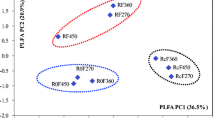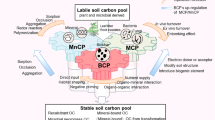Abstract
The effect of three atmospheric CO2 concentrations (ambient, 400 ppm; double, 800 ppm; and triple, 1200 ppm) on the productivity of cottonwood (Populus deltoides Barr.) and the activity of the soil microbial biomass in the root-inhabited zone was studied. The total biomass of the cottonwood increased with increasing CO2 concentration (2.28, 5.28, and 3.78 kg/tree for 400, 800, and 1200 ppm, respectively). The strongest responses were observed for the trunk and coarse roots (three and two times higher as compared to the ambient CO2 concentration). The triple concentration of CO2 had a greater effect on the roots of the trees, but the growth of leaves and branches was insignificant or absent. The shoot-to-root ratio changed as follows: 2.86, 2.80, and 1.57 at 400, 800, and 1200 ppm, respectively. The rate of C-CO2 release from the soil samples incubated for 70 days increased in the following order: 400, 800, and 1200 ppm CO2; the average values of the CO2 emission were 2.02, 2.33, and 2.76 mg/100 g per day, respectively. The greatest content of Cmb (75.1 mg/100 g) was observed in the treatment with the triple CO2 concentration, and the lowest content (53.7 mg/100 g) was found for the ambient CO2 concentration. This study suggests that the responses of the cottonwood biomass and soil microbial activity vary depending on the CO2 concentration. The microbial biomass gradually increased with increasing CO2 concentration; the total plant biomass showed the highest response at the double CO2 concentration, and the triple CO2 concentration was likely to suppress the growth of the above-ground plant biomass.
Similar content being viewed by others
References
A. Alling, M. Nelson, and S. Silverstone, Life under Glass: The Inside Story of Biosphere-2 (Biosphere Press, 1993).
J. P. E. Anderson and K. H. Domsch, “A Physiological Method for the Quantitative Measurement of Microbial Biomass in Soils,” Soil Biol. Biochem. 10, 215–221 (1978).
J. A. Arnone and J. C. Gordon, “Effect of Nodulation, Nitrogen Fixation, and CO2 Enrichment on the Physiology, Growth, and Dry Mass Allocation of Seedlings of Alnus rubra,” New Phytol. 116, 55–66 (1990).
G. Barron-Gafford, K. Grieve, K. Biel, et al., “Growth of Eastern Cottonwoods (Populus deltoids) in Elevated [CO2] Stimulates Stand-Level Respiration and Rhizodeposition of Carbohydrates, Accelerates Soil Nutrient Depletion, Yet Stimulates Above-and Belowground Biomass Production,” Glob. Change Biol. 11, 1220–1233 (2005).
F. A. Bazzaz, “The Response of Natural Ecosystems to the Rising Global CO2 Levels,” Annu. Rev. Ecol. Syst. 21, 167–196 (1990).
F. A. Bazzaz and W. Sombroek, Global Climate Change and Agricultural Production (Wiley, Chester, 1996).
G. M. Berntson and F. A. Bazzaz, “Nitrogen Cycling in Microcosms of Yellow Birch Exposed to Elevated CO2: Simultaneous Positive and Negative Feedbacks,” Glob. Change Biol. 3, 247–258 (1997).
G. M. Berntson and F. A. Bazzaz, “Regenerating Temperate Forest Mesocosms in Elevated CO2: Belowground Growth and Nitrogen Cycling,” Oecologia 13, 115–125 (1998).
S. A. Billings and S. E. Zeigler, “Linking Microbial Activity and Soil Organic Matter Transformations in Forest Soils under Elevated CO2,” Glob. Change Biol. 11, 203–212 (2005).
S. A. Blagodatskii, E. V. Blagodatskaya, A. U. Gorbenko, and N. S. Panikov, “Rehydration Method for Determination of Microbial Biomass in Soil,” Pochvovedenie, No. 7, 64–71 (1987).
P. S. Curtis and X. Wang, “A Meta-Analysis of Elevated CO2 Effects on Woody Plant Mass, Form, and Physiology,” Oecologia 113, 299–313 (1998).
R. C. Dahlman, “CO2 and Plants: Revisited,” Vegetatio 104–105, 339–355 (1993).
E. H. Delucia, J. G. Hamilton, S. L. Naidu, et al., “Net Primary Production of a Forest Ecosystem with Experimental CO2 Enrichment,” Science 284, 1177–1179 (1999).
S. Diaz, J. P. Grime, J. Harris, and E. McPherson, “Evidence of a Feedback Mechanism Limiting Plant Response to Elevated Carbon Dioxide,” Nature 364, 616–617 (1993).
J. H. van Ginkel, A. Gorissen, and D. Polci, “Elevated Atmospheric Carbon Dioxide Concentration: Effects of Increased Carbon Input in a Lolium perenne Soil on Microorganisms and Decomposition,” Soil Biol. Biochem. 32(4), 449–456 (2000).
B. A. Hungate, P. Dijkstra, D. W. Johnson, et al., “Elevated CO2 Increases Nitrogen Fixation and Decreases Soil Nitrogen Mineralization in Florida Scrub Oak,” Glob. Change Biol. 5, 9–11 (1999).
T. E. Huxman and S. D. Smith, “Photosynthesis in an Invasive Grass and Native Forbs at Elevated CO2 during an El Nino Year in the Mojave Desert,” Oecologia 128, 193–201 (2001).
G. J. Hymus, D. P. Johnson, S. Dore, et al., “Effect of Elevated Atmospheric CO2 on Net Ecosystem CO2 Exchange of a Scrub-Oak Ecosystem,” Glob. Change Biol. 9, 1802–1812 (2003).
S. B. Idso and B. A. Kimball, “Seasonal Fine-Root Biomass Development of Sour Orange Trees Grown in Atmospheres of Ambient and Elevated CO2 Concentration,” Plant, Cell Environ. 15, 337–341 (1992).
C. D. Keeling and T. P. Worf, Atmospheric CO 2 Records from Sites in the SIO Air Sampling Network (Carbon Dioxide Information Analysis Center, Oak Ridge National Laboratory, Oak Ridge, 1994).
M. U. F. Kirschbaum, “Modeling Forest Growth and Carbon Storage in Response to Increasing CO2 and Temperature,” Tellus 51B, 871–888 (1999).
C. Korner and J. A. Arnone, “Responses to Elevated Carbon Dioxide in Artificial Tropical Ecosystems,” Science 257, 1672–1675 (1992).
V. N. Kudeyarov, “Estimation of Total Nitrogen in Soils and Plants,” Agrochimiya, No. 11, 125–128 (1972).
V. N. Kudeyarov, A. A. Ponizovskii, K. Ya. Bil’, et al., “Soil in the Intensive Forestry Biome at the Biosphere-2 Station, Columbia University (Arizona, USA),” Eur. Soil Sci. 35, S34–S45 (2002).
G.-H. Lin, J. Adams, B. Farnsworth, et al., “Ecosystem Carbon Exchange in Two Terrestrial Ecosystem Mesocosms under Changing Atmospheric CO2 Concentrations,” Oecologia 119, 97–108 (1999).
D. McVey, P. G. Watermann, C. N. Mbi, et al., “Phenolic Content of Vegetation in Two African Rain Forests: Ecological Interpretations,” Science 202, 61–64 (1978).
J. M. Melillo, I. C. Prentice, G. D. Farquhar, et al., Terrestrial Biotic Responses to Environmental Change and Feedbacks to Climate (Cambridge University Press, Cambridge, 1996), pp. 445–481.
R. J. Norby, J. S. Hartz-Rubin, and M. J. Verbrugge, “Phenological Responses in Maple to Experimental Atmospheric Warming and CO2 Enrichment,” Glob. Change Biol. 9, 1792–1801 (2003).
S. R. Olsen, C. V. Cole, F. S. Watanabe, and L. A. Dean, Estimation of Available Phosphorus in Soils by Extraction with Sodium Bicarbonate (USDA, Washington, DC, 1954).
E. Paterson, E. A. S. Rattray, and K. Killham, “Effect of Elevated Atmospheric CO2 Concentration on C Partitioning and Rhizosphere C Flow for Three Plant Species,” Soil Biol. Biochem. 28, 195–201 (1996).
H. Poorter, C. Roumet, and B. D. Campbel, “Interspecific Variation in the Growth Response of Plants to Elevated CO2: A Search for Functional Types,” in Carbon Dioxide, Populations, and Communities, Ed. by C. Korner and Bazzar (San Diego, 1996), pp. 375–412.
J. D. Rhoades, “Soluble Salts,” in Methods of Soil Analysis, Part 2: Chemical and Microbiological Properties Ed. by A. M. Page, R. H. Miller, and D. R. Keeney, (ASA, Madison, WI, 1982), pp. 167–179.
H. H. Rogers, C. M. Peterson, J. N. McCrimmon, and J. D. Cure, “Response of Plant Roots to Elevated Atmospheric Carbon Dioxide,” Plant, Cell Environ. 15, 749–752 (1994).
H. Rouhier, G. Billes, L. Billes, and P. Bottner, “Carbon Fluxes in the Rhizosphere of Sweet Chestnut Seedlings (Castanea sativa) Grown under Two Atmospheric CO2 Concentrations: 14C Partitioning after Pulse Labeling,” Plant Soil 180(1), 101–111 (1996).
D. S. Schimel, “Terrestrial Ecosystems and the Carbon Cycle,” Glob. Change Biol. 1, 77–91 (1995).
M. Scholes, D. Powlson, and G. Tian, “Input Control of Organic Matter Dynamics,” Geoderma 79, 25–47 (1997).
K. V. R. Shafer, R. Oren, D. S. Ellsworth, et al., “Exposure to an Enriched CO2 Atmosphere Alters Carbon Assimilation and Allocation in a Pine Forest Ecosystem,” Glob. Change Biol. 9, 1378–1400 (2003).
I. Stulen and J. Hertog, “Root Growth and Functioning under Atmospheric CO2 Enrichment,” Vegetatio 104–105, 99–115 (1993).
R. B. Thomas and B. R. Strain, “Root Restriction as a Factor in Photosynthetic Acclimation of Cotton Seedlings Grown in Elevated Carbon Dioxide,” Plant Physiol. 96, 627–634 (1991).
G. Tian, B. T. Kang, and L. Brussaard, “Biological Effects of Plant Residues with Contrasting Chemical Compositions under Humid Tropical Conditions: Decomposition and Nutrient Release,” Soil Biol. Biochem. 24, 1051–1060 (1992).
G. Tian, B. T. Kang, and L. Brussaard, “Effect of Chemical Composition on N, Ca, and Mg Release during Incubation of Leaves from Selected Agroforestry and Fallow Plant Species,” Biogeochemistry 16, 103–119 (1992).
H. A. Torbert and H. B. Johnson, “Soil of the Intensive Agriculture Biome of Biosphere-2,” J. Soil Water Conserv. 56, 4–11 (2001).
T. O. Veteli, K. Kuokkanen, R. Julkunen-Tiitto, et al., “Effect of Elevated CO2 and Temperature on Plant Growth and Herbivore Defensive Chemistry,” Glob. Change Biol. 8, 1240–1252 (2002).
D. R. Zak, K. S. Prtegitzer, P. S. Curtis, et al., “Elevated Atmospheric CO2 and Feedback between Carbon and Nitrogen Cycles,” Plant Soil 151, 105–117 (1993).
Author information
Authors and Affiliations
Rights and permissions
About this article
Cite this article
Kudeyarov, V.N., Biel, K., Blagodatsky, S.A. et al. Fertilizing effect of the increasing CO2 concentration in the atmosphere. Eurasian Soil Sc. 39 (Suppl 1), S6–S14 (2006). https://doi.org/10.1134/S1064229306130035
Received:
Issue Date:
DOI: https://doi.org/10.1134/S1064229306130035




